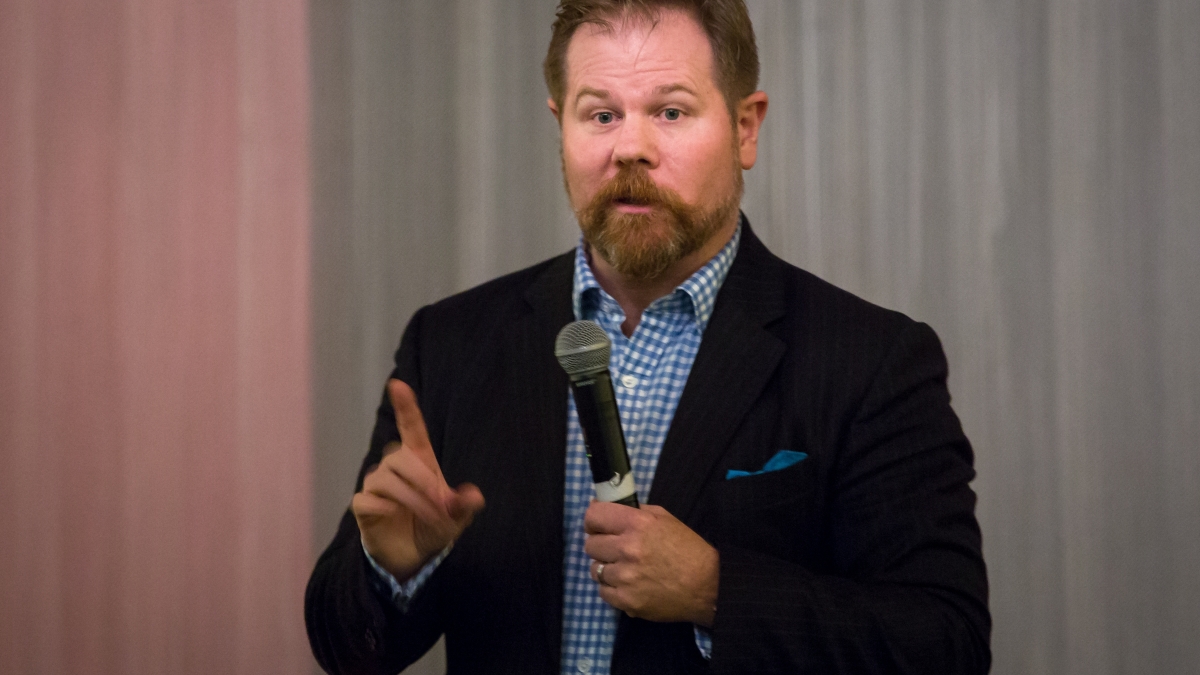More violent attacks are nearly inevitable in Europe because terrorists in the post-9/11 era strike with almost no planning, which makes counterterrorism very difficult, according to an international expert on war.
David Kilcullen, an Arizona State University Senior Future of War Fellow (pictured above), discussed “What the Rise of ISIS Tells Us About the Unraveling of the War on Terrorism” on Thursday in Tempe. He is a former special adviser to U.S. Secretary of State Condoleezza Rice and former senior adviser to Gen. David Petraeus in Iraq.
His talk was part of the spring lecture series sponsored by ASU’s Center on the Future of War.
“(The ad-hoc terrorists) look like an amorphous virus or gas rather than a structured terrorist organization, and that makes it incredibly difficult for an intelligence organization to predict those attacks,” Kilcullen said. “The shooters don’t know until two hours before that they will do it."
Kilcullen said that there is evidence of 400 to 600 operatives in Europe, mostly European citizens.
“If you think the government can do anything to prevent attacks, it’s a fantasy,” he said.
ISISISIS stands for the Islamic State in Iraq and Syria. It is also referred to as the Islamic State in the Levant (ISIL) or just the Islamic State. is a three-layered entity, according to Kilcullen, who is the author of the new book “Blood Year: The Unraveling of Western Counterterrorism.”
First, it is essentially a city-state, controlling a population of about 6 million, with revenue of around $600 million, mostly from taxation, trade and extortion. It has 25,000 full-time professional fighters, plus courts, hospitals and a police force.
“It matters because it’s not just a terrorist organization. The damage that is being done is much more in the nature of a revolutionary state that has generated 11 million asylum seekers and killed more than 400,000 people,” he said.
The second level to ISIS is its overseas territories, with about a dozen in Africa, the Middle East and a new one in the Philippines. Those also have about 25,000 full-time fighters.
“The third layer is numerically harder to pin down, but we’re looking at about 200,000 people globally that are individuals or small cells. These are people who are willing to engage in terrorism in their own country,” he said.
The three levels support each other and are mutually reinforcing.
“That’s made it incredibly resilient — significantly more than what we saw in Al Qaeda either before or after 9/11,” he said.
Kilcullen said that ISIS has recently lost some territory in Iraq and Syria.
“What we see is as they lose that, they’re striking out elsewhere — Paris and Belgium — as a way of counteracting that loss of terrain,” he said.
Kilcullen blamed the rise of ISIS on two moves by the United States: the invasion of Iraq in 2003 and the pullout of troops in Iraq in 2011.
“We should never have been in Iraq in the first place. It was a massive distraction from defeating Al Qaeda in Afghanistan,” he said.
Also, the military presence in Iraq created enough stability for ISIS to surge, he said.
The massive influx of refugees in Europe has led to a destabilization that could have negative effects.
“We’ll see one of two outcomes,” he said. “Either they will fail to integrate this group of people and we’ll see long-term unrest in Europe within the next two or three years.
“Or, if they successfully absorb this large number of people, the character of Europe will change as a result and our partnerships will change as a result.”
Kilcullen said that there’s a strong case for limited military engagement to deal with the threat of ISIS, but not a full ground war.
In the discussion after his talk, Kilcullen was asked why the United States doesn’t just disengage from the conflict.
“I’m sorry to say that there’s no drawbridge,” he said.
“The threat is here already. The world as we see it today is dramatically more dangerous than at the time of 9/11.”
The next lecture in the spring series from ASU’s Center on the Future of War is Thursday, April 7, when Pulitzer Prize-winning journalist David Wood will discuss “The Human Dimension of War. ” He will speak at 6:45 p.m at Cronkite Theatre in the Walter Cronkite School of Journalism and Mass Communication, 555 N. Central Ave., Phoenix.
Top photo by Charlie Leight/ASU Now
More Local, national and global affairs

Video series tells story of 'Resettled People'
What better way for the story of former refugees to be told than having the refugees tell those stories themselves.That’s the idea behind "STEM Dreams in Motion: Stories of Resettled People."Using…

Department of State and ASU host Government Leaders Forum to strengthen semiconductor supply chains
By Emilia FrancoAs the global demand for semiconductors accelerates — with projections reaching $1 trillion by 2030 — Arizona State University, in partnership with the U.S. Department of State,…

Environmental writer, ER doctor address violence, climate change, more at sold-out ASU event
“The difficulty of understanding the consequences of heat is amplified by conventional notions of what it means to be hot. In pop culture, hot is sexy, hot is cool, hot is new…” That excerpt was…
